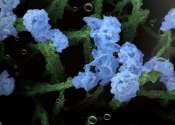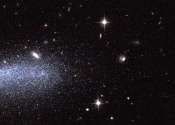Warmer summers risk chilling energy bill hikes at supermarkets
A new report from Imperial and Sainsbury's outlines how well-managed fridges can keep food cooler, be greener, and cut costs.

A new report from Imperial and Sainsbury's outlines how well-managed fridges can keep food cooler, be greener, and cut costs.
Economics & Business
Jul 3, 2020
0
3

Easily produced, nature-like nanostructures of cobalt phosphide are highly effective catalysts for the electrolysis of water, according to research performed by chemist Ning Yan and his team at the University of Amsterdam's ...
Nanomaterials
Jul 3, 2020
2
1202

The coffee-stain effect is a well-known effect in physics and daily life in which a dark-colored edge remains when a fluid containing particles evaporates. This is caused by an "avalanche" of particles moving to the outer ...
Soft Matter
Jul 3, 2020
3
137

A new discussion paper published in Policy Sciences by two Leiden researchers claims that governments are working with one hand tied when it comes to data on vulnerable groups. At the core of this paper is the idea that even ...
Political science
Jul 3, 2020
0
6

Civil society groups have played an important role in responding to the COVID-19 social crisis in South Africa. Examples include the "community action networks" in Cape Town and Gauteng, as well as similar initiatives in ...
Political science
Jul 3, 2020
0
0

Skoltech researchers, together with their industrial colleagues and academic partners, have cracked a 1960s puzzle about the crystal structure of a superhard tungsten boride that can be extremely useful in industrial applications, ...
Materials Science
Jul 3, 2020
1
30

At first sight, this image from the NASA/ESA Hubble Space Telescope portrays the sparkling stars of AGC111977, a dwarf galaxy located around 15 million light years away and visible in the lower left part of the image. Other ...
Astronomy
Jul 3, 2020
0
613

A team of researchers, affiliated with UNIST has come up with a novel electrode that could greatly improve the stability of perovskite solar cells (PSCs), the most promising candidate for the next generation solar cells due ...
Nanomaterials
Jul 3, 2020
0
287

River water, lake water, and seawater contain DNA belonging to organisms such as animals and plants. Ecologists have begun to actively analyze such DNA molecules, called environmental DNA, to assess the distribution of macro-organisms. ...
Plants & Animals
Jul 3, 2020
0
5

In a paper that made the cover of the journal Applied Physics Letters, an international team of researchers has demonstrated an innovative technique for increasing the intensity of lasers. This approach, based on the compression ...
Optics & Photonics
Jul 3, 2020
2
2846